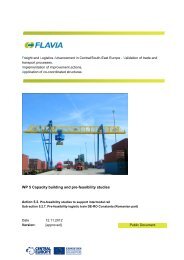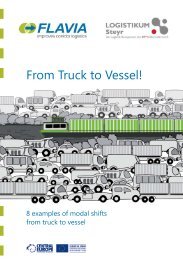SWOT-Analysis - FLAVIA
SWOT-Analysis - FLAVIA
SWOT-Analysis - FLAVIA
You also want an ePaper? Increase the reach of your titles
YUMPU automatically turns print PDFs into web optimized ePapers that Google loves.
Freight and Logistics Advancement in Central/South-<br />
East Europe - Validation of trade and transport processes,<br />
Implementation of improvement actions, Application<br />
of coordinated structures<br />
W4 antiqued infrastructure<br />
Evaluation A:<br />
Antiqued infrastructure is assessed as high obstacle because in many TRACECA countries the<br />
infrastructure does not reflect the needs of transportation network. In addition there are missing<br />
intermodal facilities like container equipment at ports and inland terminals. This causes infrastructural<br />
bottlenecks for the region. For example, the strategy for the development of the transport<br />
infrastructure of the Republic of Bulgaria mentions that the conditions of the technical situation<br />
and level of maintenance of the current transport infrastructure, as well as the outdated<br />
transport technology and equipment is not satisfying.<br />
W5 problems with realizing safe, secure and sustainable transport chains (transport<br />
quality)<br />
Evaluation A:<br />
The obligatory safety and security standards along an intermodal supply chains are not given.<br />
Here the areas of risks are storage places, transport processes on risky routes and transhipment<br />
processes. Loading units and wagons are facing high potential of external manipulation<br />
due to low security standards. The analyses of cross boarder processes indicate that time consuming<br />
procedures have increased due to additionally security checks. Hence – an adequate<br />
mix of controls and quality level is not found yet.<br />
W6 Licenses<br />
Evaluation A:<br />
This barrier includes aspects like access to infrastructure, open access to the network, complexity<br />
of homologating rolling stock (only rail), time for licensing, complexity of licensing and for<br />
getting a driver licence, power of the independent inspection authorities and the captain's certificate<br />
of competency. Here competitive disadvantages for intermodal transports are given. Especially<br />
for rail transports, as they are affected through long waiting times, additional costs, complex<br />
procedures, unclear responsibilities and a lack of planning reliability.<br />
W1 Unstable framework conditions<br />
Evaluation B:<br />
From the <strong>FLAVIA</strong> point of view, a big weakness is the legal framework concerning regulatory<br />
policies. Different transport policies are not harmonized and therefore a common strategy to<br />
push existing cooperation’s is difficult to reach.<br />
W2 lack of integration and cohesion of transport infrastructure networks<br />
Evaluation B:<br />
Here the lack of the railway infrastructure where sufficient speeds for freight trains are not possible<br />
can be mentioned. Further, in many countries suffer from an insufficient number of specialized<br />
terminals and from the lack of modern logistics and information systems. Another point of<br />
interest is the maintenance of the existing infrastructure network. Due to lack of maintenance<br />
funds and postponed repair works the infrastructure is in bad condition. Poor technical parameters<br />
cannot guarantee a high level of safety and security according to European standards.<br />
- 22 -




